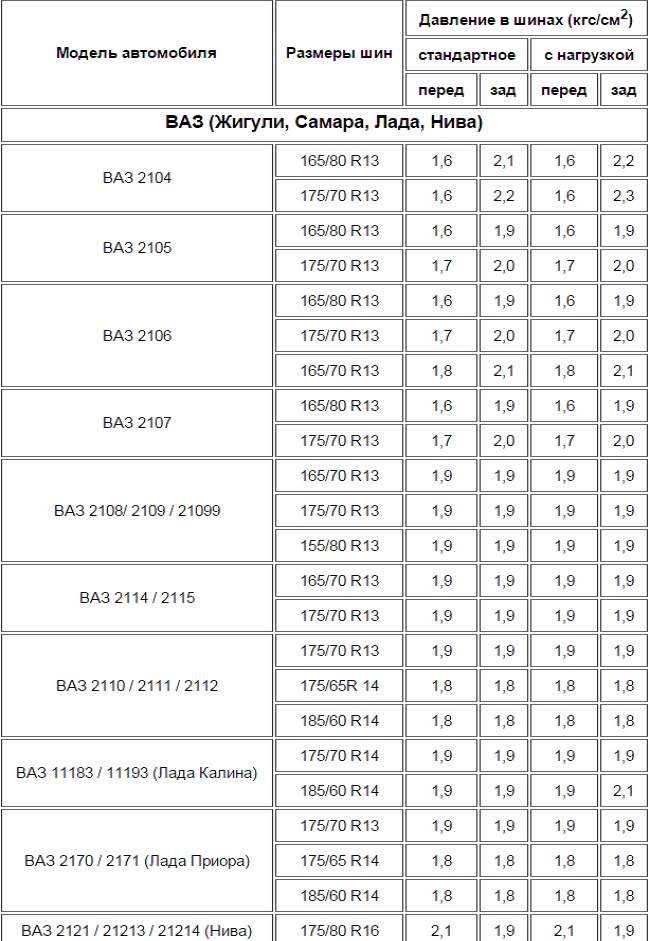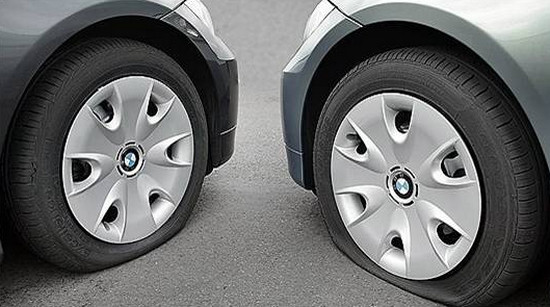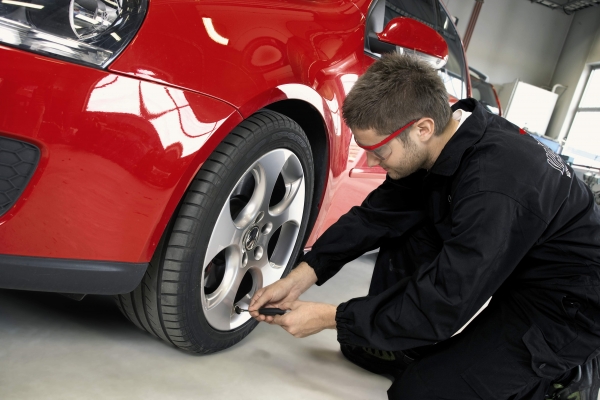When operating a vehicle, it is very important to check the tire pressure regularly. Increasing or decreasing pressure can change fuel consumption, accelerate tire wear, and even affect driver safety. The car owner must remember what tire pressure is recommended by the car manufacturer, and try to maintain it at the desired level.
Tire pressure table for the most popular cars
Each car model has its own indicator of optimal pressure recommended by the manufacturer. Usually a special sticker with the necessary data is pasted on the body in a certain place. Most often it can be found on the front door on the driver's side or on the glove box lid. If the owner of the car is having difficulty finding the sticker, the necessary information can be found in the instruction manual that should be included when buying a car.
With the development of information technology, the necessary data has become available on the Internet, if necessary, the car owner can obtain information about the recommended tire pressure of his vehicle from the following tables:

What does tire pressure affect?
What technical characteristics can be affected by tire pressure?
1. Fuel consumption. Changing the area of tire contact with the road changes the rolling resistance, which in turn affects fuel consumption. As resistance increases, fuel consumption increases as the vehicle needs to maintain its normal driver-initiated driving pattern under increased load.
2. Tire wear. A change in the contact area of the tire with the road also affects the wear of rubber. The larger the friction area, the faster the tires wear out. They are also likely to wear unevenly.
3. Clear steering. When the tire pressure changes, the car may lose the maneuverability familiar to the driver, and the braking distance also changes. Such changes, at a minimum, cause inconvenience to the driver, and in the worst case, they can be simply dangerous.
4. Ride comfort. Under-inflated or over-inflated tires can cause driver discomfort while driving.
5. Wear of suspension elements. When tire pressure changes, the load on the suspension can increase, which will lead to a faster depletion of its resource.

What is the danger of low and high tire pressure?
Incorrect tire pressure can lead to unpleasant and dangerous consequences for the driver.
If the tires are overinflated and the pressure in them is higher than normal, the following symptoms may occur:
- hard pumped tires cause shaking while driving, in this case the driver and passengers feel hitting every pebble on the road;
- high tire pressure makes them more susceptible to damage when a car hits a stone or a pothole, since the hard surface of the tires, not capable of slight deflection, will simply break through, and the suspension or its elements may be damaged if it hits a pothole;
- for heavily inflated tires, the recommended contact area with the road decreases, which can cause uneven tire wear and erasure of the tread pattern;
- the appearance of strong noise when driving on overinflated tires causes inconvenience to the driver and passengers;
- a decrease in the area of \u200b\u200bcontact of the wheel with the road makes it easier to move the steering wheel, and during traffic emergencies can occur in which seconds decide, and a change in the usual characteristics of a car can lead to a disastrous result.

Reducing tire pressure causes other, no less unpleasant, consequences:
- low tire pressure increases the area of contact with the road, as a result, fuel consumption increases, and the driver has a high chance of getting stuck with an empty tank in the middle of the highway, several kilometers before reaching the gas station;
- an increase in the area of \u200b\u200bcontact of the tire with asphalt accelerates its wear and increases the costs of the car owner for replacing rubber, and a tire heated by friction can simply burst while driving;
- increased rolling resistance of the car leads to a loss of its maneuverability, it becomes harder for the driver to turn the steering wheel, and if there is a threat of an accident, he loses a few precious seconds that can affect the outcome of the incident;
- low pressure changes the angle of inclination of the wheel, while the car loses stability, and there is a risk of the vehicle skidding when turning on a large one.

All of the above leads to the conclusion that the car owner needs to regularly check the pressure in the tires of his car and, if necessary, pump them up or bleed excess air until the indicator set by the manufacturer is reached. The pressure in is measured using a manometer, which is connected to the unscrewed nipple. In modern car models, tires have special sensors that reflect the current state of affairs.
There are several recommendations for maintaining the necessary pressure:
- the pressure is measured on cold tires, since when driving they heat up, and the pressure due to this increases;
- The pressure recommended by the manufacturer is applicable to the factory-installed tire sizes. —- if the owner of the car has installed tires of a different size, he should familiarize himself with the recommendations of the tire manufacturer and determine the optimal pressure empirically;
- carry out pressure checks once a week, as well as before long trips, so that there are no unpleasant surprises on the road;
- carry out pressure control when the temperature changes outside, especially in the off-season and in winter, since the temperature difference can change the tire pressure indicator.

Sometimes the pressure in the car is specially reduced. The decrease is made in the case of loading the car with a heavy load, since a large weight causes a natural increase in tire pressure. In this case, you should check the pressure indicator after loading the car. It is also a good idea to lower the tires before a long trip or off-road trip.







